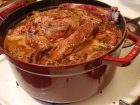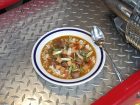
Recipe rescue: The spice of life
Patrick Mathieu
Features Health and Wellness Nutrition annex firefighterNow that fall is upon us and the cold winter months are right around the corner, this is my favourite time to spend free days in the kitchen creating some new recipes. I like to think of a new dish as a blank canvas; what can I do to make this canvas really pop? I have always prided my cooking on bold flavours, and I have learned over the years that spices are what bring the blank canvas to life.
Spices allow you to be creative and adventurous in the kitchen, but, even better, they prevent you from ever eating another blasé meal. The world of spices can be intimidating. I am often asked in my cooking classes about different spices. When and how do I use them? Which ones do I use together? How long do they keep in the cupboard? I’m sure you have countless spice bags and jars, some with a little dust on them, in your kitchen. Like any cooking technique, the more you practise using spices, the better you will become.
Spices can serve several purposes in the kitchen; they can be used to add flavour and aroma, transforming a meal in seconds. Cinnamon, nutmeg or cardamom can add a hint of sweetness; use cayenne or ginger for a kick of heat; cumin for smokiness; and coriander, turmeric, and allspice for earthiness. All of these spices can also add a great aroma. Spices give a dish its distinct aroma, and can make any creation more appealing.
Spices also enhance the taste of food. Too often, we think of salt as our go-to for fixing a bland meal, but there are other spices, such as cumin, that bring out the natural flavours of food. Spices can even change or enhance colour of food. In certain cuisines, such as Indian or Moroccan, many of the dishes have a deep yellow, orange or red colour; that’s because the spices – such as turmeric and paprika – add colour to the food, making a dish brighter and more visually appealing.
Unlike herbs, which come from the leaves of plants, spices come from the roots, seeds, bark or fruit of plants. Spices usually come in two forms: whole and ground. Each can be used for different applications. Take cumin or cardamom for example: when ground, these spices can be sprinkled on a dish; but when used whole, they can be dry toasted or fried in hot oil to lend complexity to the dish and bring out a big punch of flavour. While the convenience of buying ground spices can’t be beat, I suggest purchasing whole spices whenever possible and grinding them yourself. This will, without a doubt, provide a superior flavour and the spices themselves will last longer.
Storing spices properly is as important as knowing how and when to use them. Spices are sensitive to light, heat and moisture. Make sure they are stored in an airtight jar or container, in a cupboard or drawer far away from the stove and sunlight. A particular spice’s shelf life really depends on the spice and whether it is whole or ground. All spices will eventually lose their colour and flavour so avoid buying huge amounts at one time. If stored properly, whole spices can last up to two years, while ground spices will lose their punch after just one year. The best test is to see if a spice still has some life is to smell it. Trust your nose; spices should have a very pronounced aroma. When using spices, be sure to measure them using a dry spoon, or pour the desired amount into the your palm before adding it to a dish. Avoid shaking spices directly into a pot or pan as that can expose your spice to unwanted heat and moisture, which will lead to flavour loss and caking.
The next step is to get to know your spices; this means understanding how and when to use them. Below are a few of my favourite spice blends.
- Chili powder (spicy, smoky) – ancho chili, paprika, cumin, Mexican oregano.
- Herbs de Provence (earthy) – rosemary, marjoram, thyme, oregano, sage, tarragon.
- Ras El Hanout (spicy, sweet) – cardamom, clove, cinnamon, paprika, coriander, cumin, nutmeg, peppercorn, turmeric.
- Curry powder (warm, spicy) – turmeric, coriander, cumin, fenugreek, red chili pepper.
- Cajun (spicy, earthy) – black pepper, paprika, cumin, cayenne, thyme.
- Caribbean – allspice, nutmeg, garlic powder, cloves, cinnamon, ginger.
- Mexican – coriander, cumin, oregano, garlic powder, cinnamon, chili powder.
- Thai – basil, cumin, garlic, ginger, turmeric, cardamom, curry powder.
- Mediterranean – oregano, rosemary, thyme, bay leaves, cinnamon, cloves, coriander, basil, ginger.
Hopefully these tips will help you get the most out of your spices. Be adventurous and creative with spices and don’t necessarily rely on a recipe; let your taste buds guide you. Before you know it big, bold flavours will be your specialty, no matter what you are cooking.
Moroccan lamb stew with olives and lemon
Ingredients
- 1/4 cup extra-virgin olive oil
- 5 garlic cloves, minced
- 1 tablespoon lemon zest
- 2 teaspoons ground ginger
- 2 teaspoons sweet paprika
- 2 teaspoons ground coriander
- 1 teaspoon ground cumin
- 1 teaspoon freshly ground black pepper
- ¼ teaspoon cayenne pepper
- ¼ teaspoon ground cloves
- Pinch of saffron threads, crumbled
- One cinnamon stick
- Kosher salt
- 1 ½ kilograms (3 ½ pounds) boneless lamb shoulder, cut into 2 ½ centimetre (1 inch) pieces
- 4 cups low-sodium chicken stock
- 3 large carrots, thinly sliced
- 1 onion, diced
- 1 cup drained and rinsed chickpeas
- 2 cups pitted jumbo green olives
- 1 cup flat-leaf parsley, chopped
- 1 cup cilantro leaves, chopped
- 3 tablespoons fresh lemon juice
- 2 cups cooked couscous, for serving
Directions
- In a large bowl, mix the olive oil, garlic, lemon zest, ginger, paprika, coriander, cumin, black pepper, cayenne, cloves, saffron, cinnamon stick and 1 tablespoon of kosher salt.
- Add the lamb and toss to coat. Refrigerate for 4 to 6 hours.
- Scrape the lamb and spices into a tagine or a cast-iron pot. Add the stock, carrots, onion and chickpeas and bring to a simmer.
- Cover and cook over low heat until the lamb is tender, about 2 hours. If any fat forms on the broth, spoon it off. Then stir in the olives.
- Cook the stew for a few minutes longer and season to taste. Remove from the heat and stir in the parsley, cilantro and lemon juice. Serve and Enjoy!
Smoked Turkey and Andouille Gumbo
Ingredients
- ¾ cup canola oil
- 1½ lb. Andouille sausage or spicy Italian, roughly chopped
- 1 cup flour
- 3 cloves garlic, minced
- 1 small red onion, minced
- 1 small white onion, minced
- 1 green bell pepper, minced
- 1 red bell pepper, minced
- 1 tablespoon granulated garlic
- 1 tablespoon granulated onion
- 2 tablespoons Cajun spice blend
- 1 teaspoon cayenne
- 1 teaspoon ground white pepper
- ½ teaspoon crushed red chili flakes
- 8-12 cups good quality chicken stock (number of cups depends on desired thickness)
- 0.7 kilograms (1½ pounds) smoked turkey breast or smoked turkey thighs, cut into 2-centimetre pieces
- 3 tablespoons Worcestershire sauce
- Kosher salt, to taste
- Cooked white rice, for serving
- Fresh chopped parsley and green onion, for garnish
Directions
- Heat two tablespoons of oil in a large Dutch oven over medium-high.
- Cook sausage until the fat renders, about 8 to 10 minutes and transfer to a plate.
- Add remaining oil and sprinkle in flour; make a dark roux. This is the most important step so be patient and take your time!
- Add garlic, onions, and bell peppers; cook until soft, 10 to 12 minutes.
- Stir in granulated garlic and onion, Cajun spice blend, cayenne, white pepper, and chili flakes and cook for one minute until fragrant.
- Add stock, the sausage, the smoked turkey, Worcestershire sauce, and salt.
- Bring to a boil then reduce heat to medium; cook, stirring occasionally, until gumbo is thickened, about one hour.
- Serve with rice and garnish with fresh parsley and green onion. Enjoy!
Salmon Provençal
Ingredients
For the sauce:
- 4 large tomatoes, seeded, and finely chopped
- 2 shallots, minced
- 1 bunch fresh basil leaves, chopped (about 1 cup)
- Grated zest of ½ lemon
- ½ cup extra-virgin olive oil
- 2 tablespoons sherry wine vinegar
- 1 tablespoon minced fresh chives
- 1 tablespoon minced fresh tarragon
- Kosher salt and freshly ground black pepper
- Pinch cayenne pepper
For the salmon:
- 6 fresh salmon fillets, about 170 grams (6 ounces) each, preferably wild-caught
- Extra-virgin olive oil
- Kosher salt and freshly ground black pepper to taste
- 1 tablespoon ground fennel seed
- 1 tablespoon Herbs de Provence
- 1 tablespoon minced orange zest
- 6 small sprigs fresh organic basil, for garnish
Directions
- Make the sauce several hours ahead or the night before. In a mixing bowl, stir together the chopped tomatoes, shallots, basil, lemon zest, olive oil, vinegar, chives, and tarragon. Season the sauce to taste with salt, pepper, and a little cayenne. Cover the bowl and leave at room temperature to marinate for several hours or overnight.
- Preheat the oven to 200 C (400 F). Cover a baking sheet with foil and lightly oil the foil with olive oil. When the oven is hot, switch it to its broiler function.
- Brush the salmon fillets with olive oil, season them with salt and pepper, and press the spice blend into each fillet. Arrange salmon on a baking sheet and place under the broiler about five centimetres from the element.
- Cook until lightly browned and the flesh is still slightly pink at the center, about 7 to 8 min.
- Spoon a generous amount of the sauce onto the middle of each serving plate. Place the salmon fillets on top of the sauce. Top each fillet with a basil sprig. Serve immediately. Enjoy!
Patrick Mathieu is an acting captain at Waterloo Fire Rescue in Ontario. stationhousecateringco@yahoo.ca @StationHouseCCo
Print this page


